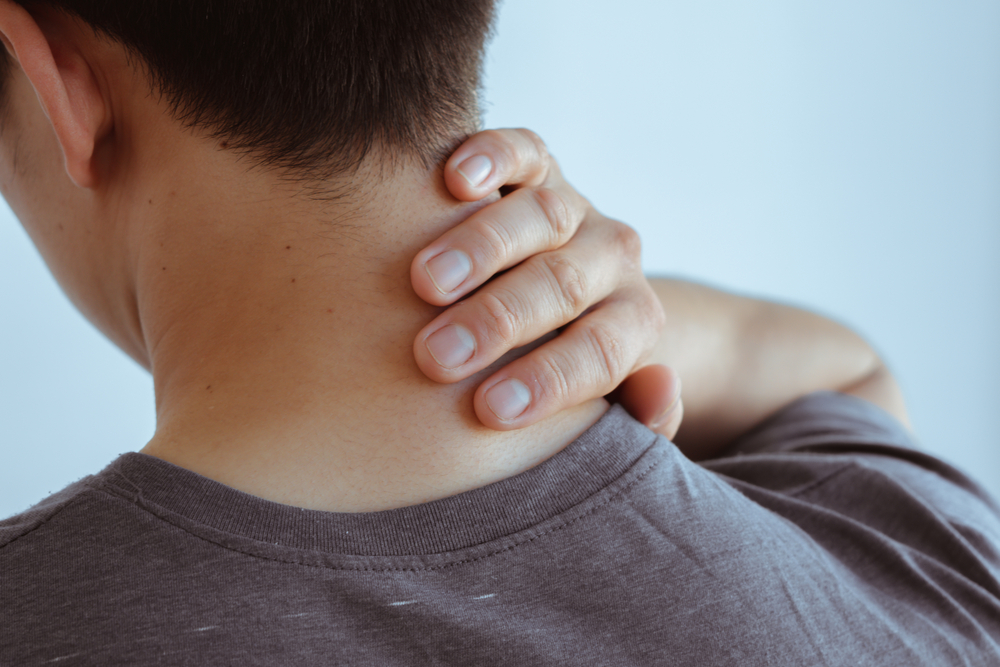It is a common misconception for someone to only come in for physiotherapy following a sports injury.
Often, many people come in with gradual onset of pain from a desk-based job with long hours of sitting.
This tends to be overlooked in a lot of office workers as it appears to be harmless, but this can creep up on you over an extended period.
It’s best to recognise early signs and prevent what seems like a small ache, escalating to full blown pain.
What are the implications for long periods of sitting and poor posture?
It’s very easy to lose track of time and sit for 8 hours straight without even realising until the end of the day.
The overall spine is a mobile structure; we are not built to be stuck in one position for hours.
This may lead to increased muscular tension and stiffness.
Common areas affected
- Upper trapezius: one of the most common areas people come in for a release
- Scalenes and sternocleidomastoid: muscles on either sides of the neck
- Neck extensors: group of muscles as the back of the neck
- Lower leg muscles as well: sitting is also a shortened position for many lower leg muscles; hamstrings and hip flexors (muscles at the front of the hip)
- Joint stiffness: as the purpose of the spine is mobility, joint stiffness is a huge contributing factor to neck, mid and lower back pain
- Headaches and dizziness
- Muscular weakness: often muscular tightness and weakness go hand in hand. Muscles follow a very simple principle; you either use it or lose it!
- Exacerbates existing spinal pain
For some people, this can lead to the development of these commonly seen presentations:
Dowager’s hump
Another term to describe excessive kyphosis (‘caving in’) of the thoracic spine which gives off a hump appearance
This is often harmless and non – symptomatic but some people do experience neck and upper back pain
Upper cross syndrome
This is a combination of 4 things:
- Tight: upper trapezius and levator scapulae (muscles at the back of the neck and upper back)
- Tight: pectoral muscles (chest)
- Weak: deep neck flexors (smaller muscles at the front of the neck that are often under-activated)
- Weak: lower trapezius and serratus anterior (important lower scapula muscles that are easy to neglect)
Altogether, this creates a head forward posture that is usually accompanied with pain and increased sensation of tightness.
Cervicogenic headaches
Headaches derived from surrounding musculoskeletal structures.
This type of headache can refer from the base of the skull, up the back of the head and around the eyes.
It is also accompanied with reduced neck movement.
This type of presentation can get quite complex as it can be multifactorial; symptoms can develop and worsen depending on factors such as sleep quality, stress levels and job satisfaction.
It is also important to be able to differentiate between a cervicogenic headache and other types of headaches which may require medical attention.
Other types of common headaches
Tension headaches
This type of headache is the most common and feels like a tight band is wrapped around your head.
It usually presents as a mild – moderate ache that is consistent and slow building.
There is no nausea, vomiting or sensitivity to loud noises or bright lights.
These headaches are influenced by poor sleep, stress, lack of hydration etc.
Migraines
This type of headache is less common and varies in severity.
It is more prominent on one side of the head and can feel as if the head is throbbing.
It may also be accompanied by nausea, vomiting and sensitivity to loud noises and bright light.
Cluster headaches
This type of common is the least common out of all discussed; it presents as recurring episodes of headaches for weeks to sometimes months before disappearing for a long period.
It causes severe pain to one side of the head, around the around the side and front on one side of the head.
It is also accompanied by other symptoms; eye pain, eye swelling and redness, nasal discharge
Signs and symptoms of a concerning headache that requires prompt medical attention
- Onset of a new and unusual headache
- Sudden onset of pain
- Sharp, lancinating pain
- Pain that is severe and continues to worsen over time
- Recent head injury
- Loss of consciousness
If you have any concerns with headaches, it is best to get in touch with a health professional for further health screening and a more in-depth conversation regarding management.
What can be done?
- Break up sitting time: change postures. Alternate between sitting and standing by utilising standing desks.
- Set alarms or reminders for breaks
- Ensure good, ergonomic set up:
- Screen at eye level or just below
- Using back supported chair with lumbar support
- Feet flat on ground or support with a step if needed
- Shoulders neutral and relaxed, not hunched
- Strengthening: gym or Pilates
- Mobility exercises
- Increase overall activity level: besides strengthening, other aerobic activities are very beneficial.
You can also get creative and implement a quick exercise every hour; 10 squats or push ups every hour.
Encourage your colleagues to join you and set some goals.
If you have any questions or concerns with your posture or are currently facing aches and pain towards the end of the day after sitting for many hours, please get in touch with one of our friendly, experienced physiotherapists and we can help you out.


